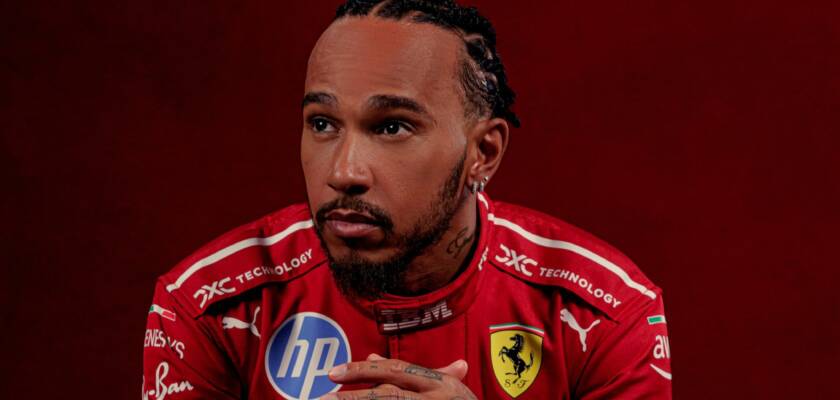The Challenges of Lewis Hamilton at Ferrari: A Season of Adaptation
Lewis Hamilton, a seven-time Formula 1 world champion, has recently made headlines due to his transition from the Mercedes team to Ferrari. This move has presented him with a unique set of challenges that have sparked discussions among fans and analysts alike. David Coulthard, a former F1 driver and commentator, has shared his insights into Hamilton’s struggles during this pivotal season. He raises questions about Hamilton’s performance and whether it signifies a decline in his racing career.
The Shift to Ferrari
After spending a significant twelve seasons with Mercedes, where he achieved unprecedented success, Hamilton now finds himself in the midst of a new and unfamiliar environment at Ferrari. The transition has not been seamless; it has required him to adapt to a different culture, team dynamics, and, most importantly, a new car. The SF-25, Ferrari’s latest model, has proven to be a challenge for Hamilton, who admits he has not yet achieved full comfort behind the wheel.
In his own words, Hamilton describes his current driving experience as “somewhat alien,” indicating that he is still in the process of adjusting to the vehicle’s unique characteristics. This struggle is compounded by the fact that he is required to adopt a driving style that is not yet instinctive for him. Unlike his previous years at Mercedes, where he developed a deep understanding of the car over time, Hamilton is now faced with the daunting task of understanding a new machine from scratch.
A New Driving Style
Hamilton has openly discussed the difficulties he faces in adapting his driving style to the Ferrari SF-25. He noted, “Ultimately, it’s a driving style that feels somewhat alien, with a car I’m not 100% comfortable with.” This statement highlights the significant shift he has had to make in order to compete effectively. He emphasizes that his previous experiences allowed him to evolve alongside his car, fostering a relationship that enabled him to know its intricacies inside and out.
In contrast, this season he arrives at each race track needing to implement a new driving technique that still feels foreign to him. His comments reflect a broader sentiment of frustration as he seeks to find his rhythm with the team. This adaptation period is crucial, as it directly impacts his performance on the track and his ability to compete with other top drivers.
The Comparison with Mercedes
Coulthard’s commentary suggests that Hamilton’s struggles may be indicative of a larger issue: a potential decline in his peak performance. He raises the question of whether Hamilton has reached the apex of his career. After years of dominating with Mercedes, the sudden shift to a less competitive position has led to speculation about his current form. Coulthard remarked, “The old cliché is that when it’s not raining, the world falls down on you,” reflecting on the challenges Hamilton has faced this season.
The former driver points out that following Hamilton’s tenure at Mercedes, where he shared the track with George Russell, he seemed to have lost some of his competitive edge. Fans and analysts had hoped that the allure and passion of the Tifosi—Ferrari’s passionate fanbase—would reinvigorate Hamilton’s spirit. However, as Coulthard notes, this has not yet materialized.
The Team Dynamics and Performance
As the season progresses, Hamilton finds himself in a challenging position, currently trailing his teammate Charles Leclerc by 46 points in the drivers’ championship standings. This gap not only highlights the differences in performance between the two drivers but also places added pressure on Hamilton to consistently outperform Leclerc. While Ferrari has yet to secure a Grand Prix victory this season, they remain in a competitive position in the constructors’ championship, sitting second with 280 points—20 points ahead of Mercedes.
This situation places Hamilton in a unique spotlight where his performance is measured against that of his teammate. As he navigates the complexities of adapting to a new team and car, the expectation is that he must rise to the occasion and deliver results that align with his illustrious career. The ongoing rivalry with Leclerc adds an additional layer of pressure, as Hamilton must not only adapt but also assert his dominance within the team.
The Road Ahead
As the season continues, Hamilton’s journey with Ferrari is a compelling narrative filled with challenges and opportunities. The question remains whether he can successfully adapt to his new environment and reclaim his status as one of the sport’s most formidable competitors. The road ahead will require resilience, determination, and a willingness to embrace the unfamiliar.
As he works to reconcile his past achievements with the present challenges, Hamilton’s journey serves as a reminder of the ever-changing landscape of Formula 1. Each season brings new competitors, technologies, and dynamics, and the ability to adapt is crucial for any driver looking to maintain their competitive edge.
Despite the hurdles he faces, Hamilton’s legacy as a racer remains intact. His ability to inspire and engage with fans, coupled with his undeniable talent, ensures that he will continue to be a significant figure in the world of motorsport. As he navigates this transitional phase with Ferrari, the hope is that he will find his footing and once again rise to the top of the podium.
In conclusion, Lewis Hamilton’s transition to Ferrari is a complex journey marked by challenges that test his adaptability and resilience. As he strives to align his driving style with the demands of the SF-25, the broader implications for his career are being scrutinized. With the relentless nature of Formula 1, Hamilton’s ability to redefine himself within this new context will ultimately shape his legacy in the sport. As fans continue to support him, the anticipation builds for what lies ahead in the remainder of the season.
